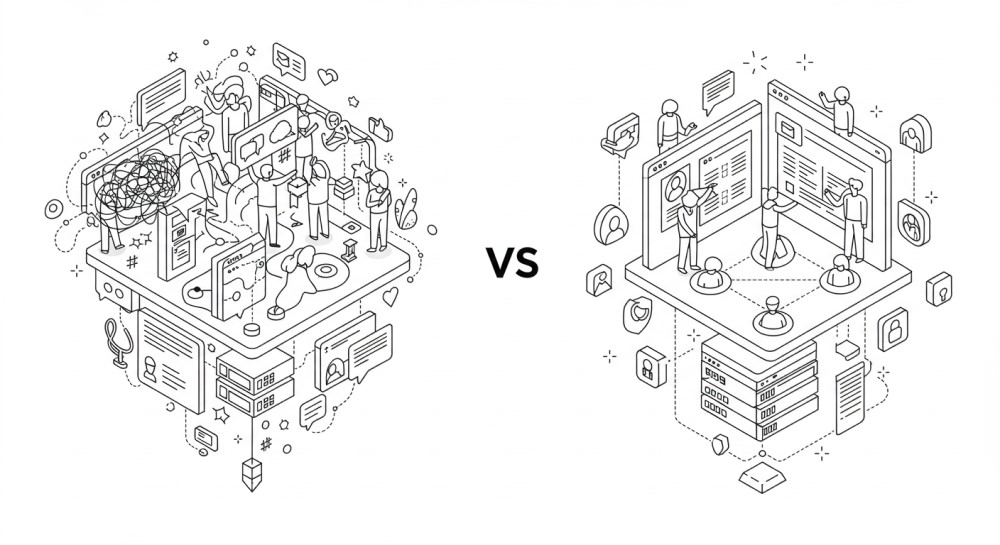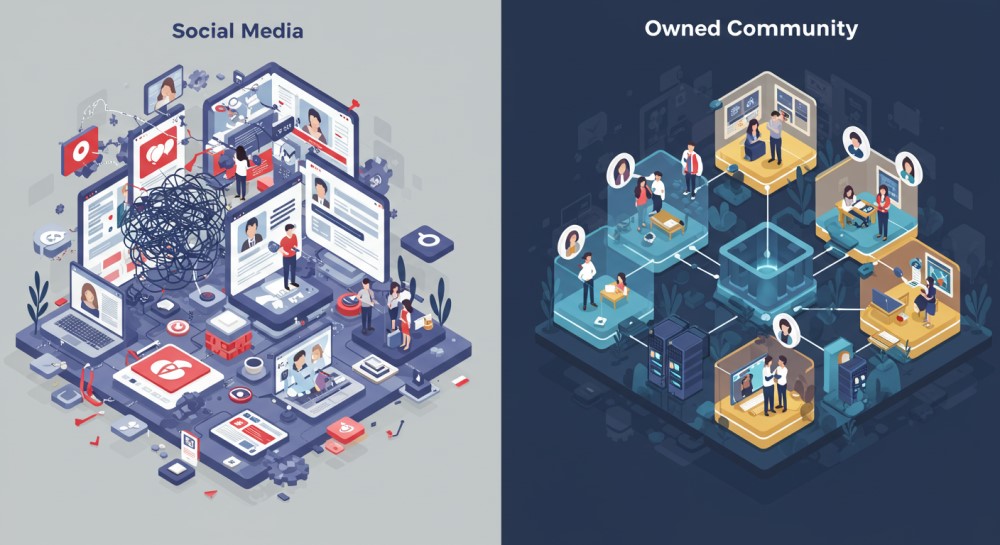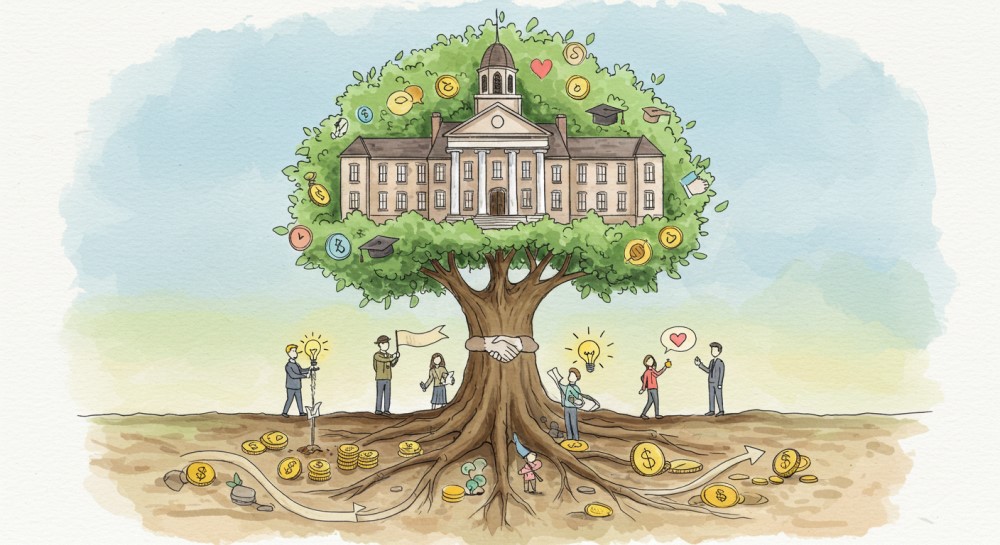How DC Hub Makes Building a Digital Community Simple and Profitable
Many organisations grasp the importance of creating digital communities to engage their audiences, but they often stumble over technical complexities and lack the diverse skill sets required to do it well. Building a digital community involves much more than picking a platform or posting content; you need strategic planning, member engagement, reliable data analytics, and a plan for long-term scalability. Without all these components—and the right people to manage them—many communities stagnate soon after launch.
Enter DC Hub, an end-to-end service designed to remove these roadblocks. By offering clear-cut tools, expert guidance, and a proven roadmap, DC Hub makes community-building both straightforward and profitable. This article explores how DC Hub sets organisations up for success, covering everything from the initial framework to sustained growth and revenue generation.
1. The Problem: Why Most Communities Don’t Scale

Constructing a vibrant online community goes far beyond selecting a platform or throwing together a forum. In reality, you need multi-disciplinary expertise—including community managers, engagement strategists, content creators, curators, data analysts, marketing professionals, partnership and business development specialists, and even behavioural psychologists. Each role contributes a vital piece of the puzzle, from setting the community’s tone to maintaining momentum and driving long-term engagement.
What’s more, successful digital communities rarely thrive on a single approach. They are inherently multi-faceted, encompassing news updates, thought-provoking content, online and offline events, job marketplaces, mentorship programmes, sub-groups, perks for members, and a host of other scalable initiatives. Most organisations simply don’t have the in-house resources or knowledge to stitch these elements together.
If they attempt to do so piecemeal—without a coherent plan—excitement wanes quickly, engagement plummets, and the community fails to deliver a return on investment. In turn, the opportunity to grow with the organisation’s evolving goals goes unrealised, wasting valuable time and budget.
2. The DC Hub Difference: A Done-for-You Model
DC Hub tackles these challenges head-on by offering a comprehensive, done-for-you solution that consolidates every aspect of community development. Rather than juggling multiple vendors, tools, or consultants, organisations gain access to a single, expert-led ecosystem. The services cover:
- Platform customisation that reflects your brand identity and functional needs
- Community planning across content, events, and initiatives—both online and offline—to provide meaningful value to members
- Member onboarding strategies for a welcoming, frictionless experience
- Retention systems that keep participation and enthusiasm high over the long haul
- Revenue model development that aligns with your community’s objectives
Moreover, DC Hub’s multi-skilled approach includes a network of subject matter experts who have helped build communities in a variety of sectors. From marketing specialists who craft effective awareness campaigns, to data analysts who fine-tune user experience, to engagement strategists who integrate offline gatherings into the digital ecosystem—DC Hub ensures every angle is addressed. The result is a unified, reliable roadmap that mitigates guesswork and puts you on the fast track to a profitable, sustainable community.
3. Designed for Engagement from Day One

Another standout feature of DC Hub is its focus on community engagement right from the outset. Rather than waiting until you’re live to “see what sticks,” DC Hub integrates proven engagement tools into the framework straight away. This ensures that members feel valued and motivated the moment they join, laying a strong foundation for loyalty and active participation.
DC Hub’s engagement strategies include:
- Personalised onboarding journeys, so new members understand how to get involved immediately
- A host of different community activities and initiatives, such as themed online meetups, curated discussions, and offline gatherings, to keep participation levels high
- Regular content prompts and structured programming to create a dynamic environment that doesn’t rely solely on spontaneous user posts
By building engagement mechanisms into the community’s core design, DC Hub nurtures a self-sustaining ecosystem. When members see that their contributions are heard, appreciated, and can lead to real-world connections, they become natural advocates—fueling growth and reducing the need for constant administrative intervention.
4. Building a Digital Community: What You Do vs. What DC Hub Does
Below is a quick comparison between the traditional in-house approach to community building and how DC Hub simplifies the process:
| Community Task | Traditional Approach (You Do It) | With DC Hub (We Handle It) |
| Platform Research & Setup | Time-consuming, confusing | Handled end-to-end |
| Engagement Strategy | Requires in-house expertise | Built for you by specialists |
| Content Planning | Inconsistent or unclear | Strategised, scheduled, and supported |
| Member Onboarding | Often overlooked | Automated and optimised |
| Monetisation Model | Hard to implement | Custom revenue paths built in |
In this overview, you can see how DC Hub strips away the complexity and guesswork. Rather than juggling fragmented solutions, you gain an expert partner who saves you time, lowers risk, and boosts outcomes.
5. Monetisation Built In, Not Bolted On

Many communities treat revenue generation as an optional add-on—something to consider only once membership hits a certain threshold. DC Hub takes a different tack by weaving monetisation opportunities into the community’s design from the start. By aligning income strategies with audience interests, DC Hub ensures that monetisation enhances rather than detracts from member value.
Common revenue models include:
- Membership subscriptions for premium content, early access, or exclusive offline gatherings
- Tiered content that segues from free resources to advanced materials
- Online and offline workshops led by industry experts, accessed via paid tickets
- Brand sponsorships that reflect members’ preferences and the community’s ethos
Because monetisation is seamlessly integrated, you won’t struggle to justify paywalls or sponsorships down the line. Instead, members recognise the additional benefits as part of the community’s natural evolution, keeping them engaged and increasing the long-term viability of your digital hub.
6. Who It’s For: Ideal Clients and Use Cases
DC Hub’s flexible, multi-faceted approach works for an array of organisational types:
- Industry associations, seeking ongoing dialogue and networking for professionals
- Educational institutions, building communities for alumni, students, or extended learning pathways
- Nonprofits, aiming to engage donors, volunteers, and cause supporters around a shared mission
- Thought leaders and coaches, looking to transform an online following into a monetised, interactive community
- SaaS companies, building user groups to share insights, resolve issues, and drive brand advocacy
Whether you’re starting from scratch or revitalising a stagnant community, DC Hub tailors its services to help you meet—and exceed—your goals.
7. Long-Term Success, Not Just Launches

While many services focus solely on a flashy debut, DC Hub is committed to long-term success. Once your community is up and running, you benefit from continuous support, strategic insights, and best-practice sharing across DC Hub’s network of clients. This includes:
- Ongoing community management, ensuring communication and moderation remain consistent and constructive
- Regular strategy reviews, adapting content and engagement tactics as member needs and market conditions change
- Growth planning, identifying chances to expand your reach, form new partnerships, or introduce additional revenue streams
- Networking opportunities with other DC Hub users, offering mutual support and shared learning
By actively guiding your community’s evolution, DC Hub helps you avoid post-launch stagnation. Instead, your online platform remains dynamic, relevant, and aligned with the changing priorities of your organisation.
Conclusion – A Simpler, Smarter Way to Build Digital Communities That Work

By adopting a holistic, multi-disciplinary approach, DC Hub eliminates the confusion that often hampers community-building efforts. From platform selection and onboarding to event planning, mentoring programmes, data analytics, and beyond—every step is orchestrated by specialists who know how to foster genuine engagement, both online and offline.
The result? A community that resonates deeply with its members, promotes shared interests, and generates sustained revenue. Backed by DC Hub’s robust roadmap and experienced professionals, you can transform what might have been a daunting project into a streamlined, results-driven journey. You’re not simply launching a platform; you’re creating an ecosystem primed to adapt, expand, and profit well into the future.
The Future of Digital Communities: Trends Organisations Need to Watch
Digital communities are no longer just about forums or social groups; they have become integral parts of an organisation’s strategic framework. Fueled by continuous shifts in user behaviour and advancements in technology—particularly artificial intelligence (AI)—these online spaces are poised for rapid transformation. Forward-thinking organisations that embrace emerging trends can strengthen their communities, enhance user satisfaction, and unlock new avenues for growth.
This article delves into the future-facing changes that will redefine how communities are built, managed, and monetised. From AI-driven personalisation to decentralised ownership models, these trends offer a glimpse into what the successful future of digital communities may look like over the coming years.
1. AI-Powered Personalisation and Moderation

One of the most significant developments shaping the future of online communities is the rise of machine learning tools that both customise experiences and uphold community standards. On the personalisation side, AI can quickly analyse user data—interests, participation patterns, and social connections—to recommend posts or activities that feel directly relevant. This level of tailored content not only increases engagement but also nurtures a deeper sense of connection between members.
Equally vital is the use of AI-driven moderation to maintain a safe environment. Advanced algorithms can detect inappropriate language, spam, or harassment far more swiftly than human moderators, preventing toxic interactions from taking root.
Over time, these machine learning systems become more accurate, ensuring that community guidelines are enforced in a manner that upholds trust and psychological safety without stifling open discourse. The future thus lies in smart, adaptive platforms that continuously learn from user behaviour to provide supportive and meaningful interactions.
2. The Rise of Private, Niche Communities
In recent years, many users have grown weary of large, impersonal social media platforms, preferring smaller, interest-based communities where they can connect more authentically. These private online spaces, often centred on specific hobbies or professional networks, promote deeper engagement by fostering trust and shared identity. Members value conversations that feel intimate and closely aligned with their passions or expertise.
For organisations, this trend underscores the importance of focusing on specificity rather than mere scale. While broad audiences can be tempting, targeting a well-defined niche allows for more meaningful relationships that ultimately translate into heightened loyalty and sustained interaction. Such communities can serve as fertile ground for peer-to-peer learning, networking, and co-creation, providing a distinct advantage over less focused online groups.
3. Web3 and Tokenised Communities

Another major shift is emerging through Web3 technology, which brings concepts like decentralised governance and token-gated access into the mainstream. In these models, community members hold a digital token that grants them certain privileges—such as the ability to vote on community decisions or access exclusive content. This structure fundamentally redefines community membership by giving individuals a stake in the platform’s success.
Beyond mere access, tokenisation also opens avenues for shared value creation. Members who actively contribute may receive token rewards, making community engagement both intrinsically and extrinsically motivating. Over time, these decentralised, member-driven ecosystems could transform the way people perceive community ownership, driving higher levels of participation and long-term investment in the platform’s evolution.
4. Real-Time, Multi-Channel Engagement
Today’s users expect to interact seamlessly across multiple platforms and devices, from smartphones to desktops to wearables. As such, the future of digital communities hinges on real-time interaction combined with asynchronous accessibility. Chat apps and live streaming tools enable immediate dialogue, virtual events, and instant collaboration, making members feel connected no matter where they are located.
Yet the emphasis on real-time engagement does not mean asynchronous communication is becoming obsolete. Many community members still prefer flexible conversation that fits their schedules. Forward-thinking organisations will blend these two approaches—offering immediate responsiveness when needed, while still accommodating those who engage in their own time. This balance ensures that no member feels left out or pressured, creating an inclusive environment for all types of communicators.
5. Evolving Metrics: Engagement Over Volume

Historically, many organisations have chased vanity metrics—like follower counts or page views—to gauge community success. However, modern thinking increasingly prioritises quality engagement and community health over raw numbers. Metrics that are gaining traction include:
- Member retention: How many people remain active after joining?
- Contribution frequency: Are members regularly posting, commenting, or creating new content?
- Peer-to-peer interaction: How often do members directly engage with each other, rather than just with the brand?
To track these nuances, organisations need sophisticated analytics tools that provide real-time insights and can pinpoint areas in need of improvement. By focusing on meaningful interactions rather than sheer volume, communities can ensure that users truly value their shared environment and remain committed to its ongoing success.
6. Future of Digital Communities: Legacy vs. Next-Gen Digital Community Models
Below is a comparative view of how traditional communities differ from the more future-focused models now gaining prominence:
| Feature | Legacy Communities | Future-Forward Communities |
| Platform Type | Forum-based, standalone | Multi-channel, mobile-first |
| Engagement Strategy | Moderator-led discussions | User-generated, AI-curated content |
| Monetisation Approach | Ads and brand partnerships | Memberships, tokens, co-creation |
| Member Role | Passive consumers | Active contributors and co-owners |
| Data Ownership | Centralised | User-controlled (Web3-inspired) |
This table highlights critical evolutions—from content creation strategies to monetisation models—that underpin the next generation of online communities.
7. The Blurring of Community, Content, and Commerce

As digital ecosystems mature, the lines between community interaction, content creation, and commercial activities are becoming increasingly blurred. Rather than existing as separate spheres, these elements now intertwine to form continuous user experiences. Communities that offer content relevant to members’ interests can naturally transition into commerce opportunities, such as product recommendations, affiliate links, or premium membership tiers.
This convergence of engagement and transaction creates a content-commerce hybrid, whereby members perceive purchases not just as commercial exchanges but as extensions of their community involvement. For brands, this model can be highly profitable and loyalty-building, as users feel more emotionally invested in a space that supports both social connection and tangible transactions.
8. Ethical Design and Digital Wellbeing
As community platforms become more immersive and all-encompassing, the responsibility to ensure user wellbeing increases. Contemporary digital spaces must incorporate features that encourage healthy online habits, such as time management tools or reminders to take breaks. Equally important is a commitment to diversity and inclusion; communities should have clear policies in place to protect marginalised voices, limit harassment, and promote respectful discourse.
In the future, we can expect a stronger focus on empathetic design, where user interfaces and community norms are crafted with psychological safety in mind. By prioritising mental health and respectful interaction, organisations can maintain vibrant communities that serve users’ needs without overwhelming them. This approach builds trust, which in turn fosters deeper, more authentic engagement.
Conclusion – Preparing for What’s Next: How to Future-Proof Your Digital Community

The digital landscape is evolving at a rapid pace, and communities stand at the forefront of this transformation. Whether through AI-powered personalisation, decentralised ownership, or innovative engagement metrics, the next generation of community platforms will be marked by adaptability and a focus on genuine human connections. Crucially, organisations that remain agile—incorporating new technologies and redefining user experiences—will find themselves well-positioned to thrive.
However, thriving in this dynamic environment requires more than just technology adoption. It involves embracing ethical design, fostering a sense of belonging, and regularly realigning community goals with member needs. By designing spaces that are flexible, user-centric, and forward-thinking, organisations can create future-ready communities where members feel truly empowered—and stay engaged for the long run.
How Alumni Fundraising and Engagement Drives Institution Growth
Many educational institutions and nonprofits struggle to keep pace with the changing nature of alumni fundraising and engagement. Traditional methods such as direct-mail newsletters or annual reunions have often yielded short-lived interactions and minimal long-term participation. In today’s digital world, alumni expect ongoing, meaningful communication that provides real value.
Rather than relying on one-off events or sporadic updates, institutions can now leverage digital communities to establish a dynamic, year-round connection with graduates. These platforms offer a continuous space for alumni to network, collaborate, and support each other’s personal and professional pursuits.
Beyond simply deepening relationships, such communities can also serve as effective drivers of consistent fundraising efforts, creating opportunities for both one-time and recurring donations. When executed well, a digital alumni network can forge stronger bonds, broaden institutional reach, and contribute substantially to the organisation’s goals.
1. The Challenge with Traditional Alumni Programs

A primary stumbling block for educational institutions is the event-driven approach to alumni engagement. For decades, reunions or annual galas have served as the main forums for interaction. While these gatherings can indeed be memorable, they often generate only a temporary sense of connection that quickly fades once the event concludes. Institutions relying solely on these periodic touchpoints usually see inconsistent participation and limited capacity for meaningful alumni-to-alumni interaction.
In addition, the communication style in many traditional alumni programs is usually one-directional. Institutions send newsletters, magazines, or mass emails, but there’s minimal opportunity for real-time dialogue. As a result, alumni may feel like passive recipients rather than active contributors. Ultimately, these approaches can create missed opportunities: the alumni network’s potential for mentorship, fundraising, and brand advocacy remains untapped because there’s no mechanism for genuine community-building.
2. The Power of Digital Communities
In contrast to occasional events or static websites, a digital alumni community opens the door to ongoing engagement and immediate connection. By giving members a platform to share stories, experiences, and advice, you enable real-time interactions that simply aren’t possible through annual or semi-annual communications. This continuous loop of feedback and participation cultivates an environment where alumni feel their voices are heard, and their presence is valued.
More importantly, digital communities foster a vibrant, shared identity that grows over time. When alumni see tangible benefits—career support, exclusive networking opportunities, or mentorship programs—they become more invested in the institution’s success. Consequently, there’s a deeper sense of belonging that translates to higher activity levels and strong advocacy. In essence, a well-managed online community goes beyond simply providing information; it enables the co-creation of an evolving culture that resonates with both newer and older graduates.
3. Strengthening Alumni Relationships Through Community

One of the most valuable aspects of digital platforms is their ability to enable peer-to-peer interaction, not just top-down communication from the institution to alumni. Discussion boards, topic-specific groups, and private channels let graduates connect over shared interests, experiences, or professions. This horizontal form of engagement naturally encourages deeper social bonding because alumni discover common ground and mutual goals.
For the institution, these strong connections translate into greater loyalty. When alumni see that their institution is not merely promoting its own achievements but actively facilitating discussions and networking among graduates, they perceive an ongoing commitment to their well-being. Over time, this results in an alumni population that is more likely to respond positively to volunteer opportunities, fundraising initiatives, and mentorship programmes. In short, the digital community transforms the alumni-institution relationship into a robust, multi-faceted partnership.
4. Fundraising Through Community: More Than a Donation Page
Traditional fundraising efforts often rely on broad appeals or annual giving campaigns that may not feel relevant to many alumni. By contrast, digital alumni communities present a natural, ongoing context for discussions around giving. Because members are already engaged with each other and the institution, the question of donations can be woven into conversations without seeming forced or intrusive.
Additionally, institutions can develop targeted campaigns within these communities, leveraging data on members’ interests or graduation cohorts. For instance, crowdfunding initiatives can focus on specific projects—scholarships, research funds, or facilities improvements—that resonate with particular groups. Alumni are more likely to donate when they understand precisely how their contribution will be used and when they see transparent updates on campaign progress. Moreover, offering exclusive perks or acknowledgments to contributors helps build trust. This sense of recognition further motivates alumni to give repeatedly, reinforcing a culture of continuous support rather than a one-off contribution.
5. Features That Help Communities Thrive

A successful digital alumni platform depends on incorporating the right tools and features to keep members interested and motivated. Among the most beneficial components are:
- Event hosting tools: Virtual and physical meetups, panel discussions, or Q&A sessions can be arranged easily, enabling alumni from all geographic locations to attend.
- Member directories: A searchable database of alumni can facilitate career networking, mentorship, and knowledge-sharing among graduates.
- Content hubs: Providing a central repository for updates, resources, and alumni success stories keeps everyone informed and encourages the sharing of valuable information.
- Mobile access: Many alumni have busy schedules and are on the go. Having an intuitive mobile platform ensures members remain engaged, whether they’re commuting to work or travelling.
These platform features not only drive better participation but also simplify the donation journey. With built-in payment gateways or integration with existing fundraising systems, institutions can make contributing seamless and straightforward. Ultimately, the more user-friendly and interactive the community platform, the more likely alumni will find sustained value in it—and keep coming back.
6. Comparative Table: Traditional Alumni Engagement vs. Digital Communities
Below is a side-by-side comparison that highlights how digital communities can address many of the shortcomings of traditional alumni programs:
| Engagement Factor | Traditional Approach | Digital Community Approach |
| Communication Style | One-way, periodic updates via mail or email | Interactive and continuous with two-way discussions |
| Event Attendance | In-person only, location-limited reunions | Virtual and hybrid options accessible globally |
| Networking Opportunities | Few, mostly event-based or ad-hoc | Ongoing, peer-to-peer connections via dedicated channels |
| Fundraising Effectiveness | Generalised appeals that may lack personalisation | Targeted, contextual campaigns that align with alumni interests |
| Sense of Belonging | Episodic contact leading to weak engagement | Shared identity, bolstered by year-round interactions |
This table highlights the key advantages of digital communities, such as continuous communication and contextual fundraising. By shifting from isolated, in-person events to an immersive and persistent online environment with offline interaction, institutions can capture and retain the interest of alumni in more meaningful ways.
7. Real-Life Use Cases and Success Scenarios

Many universities and colleges that have embraced private or institution-specific communities have noted a substantial increase in alumni engagement. For example, event attendance sees a boost because members are continually reminded of upcoming webinars, virtual get-togethers, or panel discussions. Higher attendance often correlates with more networking, leading alumni to cultivate both personal and professional relationships within the community.
From a fundraising standpoint, these digital spaces allow institutions to run specialised giving campaigns tied to alumni milestones—such as reunion years or departmental anniversaries. By tailoring the approach to the right audience, donation drives become more impactful. These communities also serve as a prime channel for mentorship opportunities, connecting current students with experienced alumni who can offer career guidance, internships, or referrals.
In turn, this vibrant network becomes a magnet for prospective students who see tangible evidence of a supportive alumni base. Thus, the cycle of engagement grows: active alumni attract future students, and those new graduates eventually become the next generation of committed alumni.
8. Best Practices for Building a Digital Alumni Network
Building and sustaining an effective digital alumni network requires forethought, planning, and ongoing management. Here are some best practices to ensure the success of your community:
- Start with a clear mission: Define the primary objectives of your alumni community, whether it’s to foster networking, enable mentorship, drive fundraising, or all of the above. When alumni understand the purpose, they’re more inclined to participate actively.
- Develop the right platform: Develop a user-friendly platform that balances feature-rich functionality with simplicity. Alumni should find it intuitive to navigate, join discussions, and access resources.
- Build a team experienced in digital communities: Develop an experienced team of community managers, content creators, engagement specialists, data analysts etc to ensure that members remain active and engaged.
- Co-create with alumni: Involve your graduates in the design and rollout of the platform. This participatory approach not only instills a sense of ownership but also ensures that the final product resonates with users’ real needs.
- Maintain visibility: Regularly share valuable content, updates, and announcements about the institution. Host events, encourage success stories, and introduce new features or initiatives to keep the community fresh and exciting.
By adhering to these best practices, you lay the foundation for a thriving, sustainable alumni network that benefits both members and the institution at large.
Conclusion – Digital Communities Are the Future Of Alumni Fundraising and Engagement

As higher education and nonprofit landscapes continue to evolve, digital communities stand out as a strategic asset for alumni engagement. By shifting away from one-time events and limited communication channels, institutions can establish an ongoing, supportive environment that resonates with graduates’ interests and needs.
This continuous interaction not only fosters deeper relationships among alumni but also paves the way for consistent fundraising efforts, as donors have a clearer understanding of where their contributions go and how they directly impact the institution’s mission.
Ultimately, alumni are far more than a list of past graduates; they’re a living network of advocates, mentors, and benefactors. Engaging them through a dedicated online community ensures their potential is fully realised, benefiting the institution’s reputation, financial stability, and educational outcomes. Forward-thinking organisations that make this investment are poised to strengthen alumni relations and support far into the future.
The Biggest Mistakes Organizations Make When Building Digital Communities (And How to Avoid Them)
In an age of constant connectivity, many organisations recognise the potential of digital communities to keep people engaged, informed, and loyal. Whether you’re rallying fans around a shared passion or bridging employees across departments, these virtual hubs can inspire creativity and amplify brand reach.
They also offer real-world benefits—like local meetups or collaborative projects—that extend far beyond the screen. Yet despite their promise, building a digital community can pose challenges. Missteps in planning, oversight, or member engagement often lead to inactivity, frustration, and wasted resources. In fact, many of the setbacks come down to the same few patterns—mistakes organizations make when building digital communities that could easily be avoided with the right strategy and support.
In this article, we’ll explore the most common pitfalls and show you how to avoid them. By applying these strategies, you’ll lay the groundwork for a thriving, long-lasting community that truly benefits everyone involved.
1. Lack of a Clear Purpose and Strategy

A digital community without a clearly defined mission is like a ship without a compass. Members are left guessing about why the platform exists and how they’re meant to contribute. Some organisations believe any online gathering is inherently valuable, but this assumption frequently backfires when it becomes evident that nobody understands what goals they’re working towards. Are you hoping to gather customer feedback for product development? Provide professional networking? Encourage peer mentorship?
Whatever your motivation, articulate it succinctly and share it across the entire organisation. This could mean crafting a mission statement that underscores the community’s aims—be it fostering knowledge exchange, sparking innovation, or nurturing brand ambassadors.
Equally important is ensuring each department understands how the community fits into overall objectives. By defining purpose at the outset, you create a unifying vision that resonates with potential members and guides the types of conversations and events—both online and offline—that your community hosts.
2. Inadequate Planning and Resource Allocation
Building a successful digital community isn’t a one-person job. While a passionate community manager is important, you also need engagement strategists who map out campaigns, content creators who generate valuable discussions, data analysts who monitor trends, and marketing specialists who promote the community effectively. Behavioural experts and project managers can further refine how members interact, increasing satisfaction and retention rates. This blend of expertise helps ensure that your community is designed thoughtfully from the start, meeting a wide variety of member needs.
Moreover, communities require suitable funding. Don’t overlook costs for event planning—both virtual and in-person gatherings—as these can forge strong bonds among members. Budget for a platform with features like analytics, custom user profiles, and reliable hosting. Consider whether you’ll need to integrate with other organisational tools, such as CRMs or marketing software, to keep processes seamless. By taking a holistic approach to planning—from pre-launch strategy to long-term maintenance—you’re far less likely to be blindsided by unexpected expenses or logistical hurdles that could stall your community’s momentum.
3. Neglecting Member Onboarding and Engagement

A flashy platform means little if newcomers don’t feel welcomed or informed. When people first join, they should be met with clear, succinct tutorials explaining how to navigate discussions, set up profiles, and find relevant topics. Try featuring a “quick start” guide or welcome message that outlines your community’s purpose, so members understand the benefits of participating. If your space revolves around specialised interests—like a particular professional niche or hobby—provide resources that help novices quickly get up to speed.
Engagement is more than occasional updates. Schedule regular activities—like polls, Q&A sessions with experts, or creative challenges—that encourage involvement. Consider the power of storytelling: sharing member successes or spotlighting inspiring journeys can motivate others to contribute. Offline events, whether they’re small local meetups or larger conferences, add another dimension, turning virtual acquaintances into real-world connections. When members see consistent efforts to stimulate conversation and networking, they’re more likely to remain active, contribute ideas, and invite others to join.
4. Overlooking the Importance of Moderation
A digital community can quickly descend into chaos without clear guidelines and diligent moderation. In extreme cases, disrespectful behaviour, spam, or inflammatory content can dominate the conversation, deterring serious participants. To avert this, establish a code of conduct from the get-go, detailing acceptable communication standards, policies on self-promotion, and how conflicts should be resolved. Ensure moderators—whether they’re employees or trained volunteers—are well-versed in these rules and have the tools to enforce them fairly.
Moderation shouldn’t be seen as censorship but as stewardship. Besides removing malicious posts, moderators can highlight noteworthy discussions, direct new members to helpful resources, and introduce topics to revitalise stalled conversations. This creates a sense of order and trust. When members observe timely, balanced moderation, they’re more inclined to open up, share meaningful insights, and engage in thoughtful debates. Over time, a healthy culture of mutual respect emerges, drawing in like-minded individuals who value constructive dialogue—leading to a richer, more supportive community overall.
5. Prioritising Community Size Over Meaningful Engagement

Having large membership numbers might look impressive, but if members rarely participate, your community’s actual impact will be minimal. True success lies in how people interact with one another—are they sharing ideas, solving problems, forming partnerships? By zeroing in on quality engagement, you cultivate a genuine sense of belonging that transcends the initial novelty of signing up.
A few strategies can help. Organise subgroups or themed discussions where participants dive deeper into specialised interests. Host “office hours” or roundtables with industry experts. Present exclusive benefits—like early product trials or VIP event invites—to active contributors. These gestures reward commitment and make members feel appreciated. By focusing on deeper conversations and personal connections, you’ll not only see higher retention but also a more vibrant dynamic that propels your community forward.
6. Choosing the Wrong Platform for Your Community’s Needs
One critical yet often overlooked aspect of building a digital community is platform selection. Each demographic has unique preferences: some enjoy quick real-time chats, while others prefer long-form posts or asynchronous discussions. Relying solely on an external social media platform may appear convenient, but algorithm changes or policy decisions beyond your control can undermine your community.
Opt for a solution that lets you retain ownership of data, tailor user experiences, and scale as you grow. Look for flexibility in enabling offline integrations too—can the platform support event sign-ups, local meetups, or membership management? The more you can adapt the technology to fit your community’s evolving needs, the easier it will be to maintain engagement over time. Think of the platform as a foundation: if it’s strong and well-suited, you’re far more likely to build a dynamic, enduring community.
7. Ignoring Member Feedback and Data Analytics

Your community members are a treasure trove of insights, but you’ll miss them if you never ask. Frequent polls, feedback forms, and open Q&A sessions can reveal what topics or features resonate most. Combine these qualitative insights with quantitative data—like session durations, peak activity times, or popular discussion threads—to gain a comprehensive view of overall engagement.
Keep an eye on how offline events influence online participation—do face-to-face meetings encourage more robust discussions afterwards? If mentorship schemes generate rave reviews, consider expanding them to other areas. Use analytics to spot emerging trends and to identify areas where members seem disengaged. A data-driven approach ensures you’re not relying on guesswork, enabling you to make informed improvements. This continual dialogue between your community’s management and its members fosters transparency, relevance, and loyalty.
8. Failure to Adapt and Evolve
A community is a living entity that grows and changes as member interests shift. If you cling to rigid structures or outdated topics, you risk losing momentum and relevance. Instead, embrace a mindset of iterative growth. Test out new discussion formats—like virtual roundtables, problem-solving hackathons, or local meetups focused on specific challenges—then measure engagement. If something works, expand on it; if it doesn’t, pivot quickly.
Stay on top of emerging trends in your field, be it new technology, industry news, or cultural shifts. Integrate these developments into your community’s content strategy, whether through blog posts, webinars, or themed offline gatherings. Consistent innovation sends a clear message: this is a forward-thinking space where member feedback and current events shape the direction. By refining your approach regularly, you not only keep existing members interested but also attract newcomers intrigued by your evolving offerings.
Understanding the Mistakes Organizations Make When Building Digital Communities (and How to Succeed)

Establishing a vibrant, sustainable digital community is no small undertaking. It demands a clear sense of purpose, thoughtful resource allocation, structured onboarding, vigilant moderation, and a commitment to genuine engagement over superficial metrics. A well-managed community also bridges online and offline realms, offering opportunities for members to meet in person, explore shared interests, and develop trust that enriches every subsequent interaction.
By combining expertise from multiple fields—marketing, analytics, behavioural science, and project management—you ensure your community addresses various member needs and adapts effectively to change.
Crucially, success in community building is not a one-time achievement but a continuous journey. Regularly gather feedback, monitor analytics, and stay open to evolution, whether that means trying out a new technology or hosting a city-specific meetup. Over time, these efforts foster loyalty, creativity, and genuine camaraderie. In the end, a digital community that values its members, listens to them, and grows alongside their interests can become an enduring asset for any organisation.
From Social Media Scrolls to Meaningful Bonds: The Psychology of Online Communities
An endless scroll of likes and quick comments can keep people momentarily engaged, but it rarely fosters the kind of deep connections that result in long-term loyalty. Dedicated digital communities—intimate spaces where members feel valued—are fundamentally different. Beyond delivering fresh content, they address the psychological needs that truly encourage individuals to engage on a deeper level, including belonging, self-expression, mutual trust, and real-world collaboration.
Whether your community centres on a professional network, a specialised hobby, or a social cause, achieving enduring success requires more than a simple platform. By recognising why people come together online and how they build genuine bonds, you create an experience that outlasts fleeting social media trends.
This includes offering activities that blend digital and offline interactions, encouraging mentorship, and cultivating sincere relationships rather than superficial metrics. In the sections that follow, we’ll look at the psychology of online communities, exploring how to build spaces where members don’t just drop in—they stay.
1. The Human Need for Belonging: Creating Spaces for Real Connection

For centuries, we’ve met in clubs, gatherings, and social circles to satisfy our innate need for belonging. In the digital realm, replicating this sense of real community requires a focus that mass social networks often lack. Instead of getting lost in a feed of unconnected posts, members of a well-structured online group can unite around shared interests or goals, forming a collective identity that extends beyond typical “likes” or comments.
- Inclusive culture: Your community guidelines should emphasise mutual respect and constructive conversation. When people trust that their perspectives will be heard—without hostility or belittlement—they’re more likely to participate and forge deeper connections.
- Shared purpose: Whether it’s learning a new skill, supporting a movement, or celebrating a hobby, having a unifying aim enhances community stickiness. Regular online discussions and offline meetups—like workshops, local gatherings, or group dinners—further strengthen this common ground, transforming digital acquaintances into real-world friends.
As members recognise they’re part of something bigger, they invest more time and emotion into the group. This drives not only loyalty but also an eagerness to welcome newcomers, perpetuating the cycle of genuine community growth.
2. Identity and Self-Expression: Helping Members Show Their True Selves
Social media encourages quick updates, but often lacks the depth required for meaningful self-expression. Digital communities that truly succeed open the door for members to explore who they are and share it with others who genuinely care.
- Customisable profiles and subgroups: Providing in-depth user profiles or separate channels for niche interests allows people to showcase what makes them unique—be it professional expertise, a creative hobby, or personal experiences.
- Authentic storytelling: By enabling long-form posts, personal journals, or Q&A sessions, you invite members to move beyond surface-level sharing. If someone details the journey of starting a small business, for example, others can connect over similar experiences, leading to more honest, empathetic dialogue.
Encouraging members to bring these digital expressions into real-world settings—like photography clubs, study groups, or volunteering initiatives—deepens the authenticity of those profiles, as actions and engagement speak louder than static images or bios.
3. Genuine Connections vs. Surface-Level Validation

One of the biggest challenges in today’s online world is separating true relationship-building from a quick hit of approval. On large social media platforms, a ‘like’ or quick emoji often substitutes for real conversation. In a dedicated community, however, interaction becomes more thoughtful, consistent, and productive.
- In-depth feedback: Instead of random “hearts,” encourage members to offer detailed insights or constructive critique. This approach not only validates the original poster but also sparks discussions that can branch into new projects or offline meetups.
- Community highlights: Celebrating a member who organises a local event or helps fellow users navigate a tricky problem strengthens collective value. Recognising genuine contributions—like mentoring newcomers or running a webinar—reinforces that this is a place of real substance, not just surface-level praise.
Over time, these more profound forms of acknowledgment create a culture of trust, where people feel motivated to contribute because they know their efforts won’t go unnoticed. In turn, the community develops a more supportive, family-like dynamic that’s rarely found on mainstream social media.
4. Fostering Meaningful Engagement Over Empty Incentives
While some online spaces resort to gimmicky tactics—like flashy badges or constant point-scoring—such features can dilute real interactions if overused. Sincere engagement emerges from genuine interest, collaboration, and mutual learning, rather than competition for the next digital trinket.
- Purpose-driven initiatives: Align community activities with larger goals that members care about, whether it’s raising funds for a local cause, sharing professional opportunities, or engaging in skill-building workshops. When participants see the real-world impact of their involvement, they’re more likely to stick around.
- Recognition with substance: Acknowledge top contributors not merely through digital icons but through responsibilities or privileges that reinforce trust. For instance, a member who consistently shares valuable knowledge could be invited to moderate a forum thread or host an in-person event. This way, rewards deepen social bonds instead of creating a shallow hierarchy.
By prioritising authentic relationships, you ensure members aren’t just chasing status; they’re cultivating friendships and shared experiences that benefit everyone in the long run.
5. The Psychology of Online Communities: The Need for Trust, Safety, and A Holistic Team Approach

Building a thriving digital community involves more than a single community manager posting updates or approving new members. A holistic team—spanning engagement strategy, behavioural psychology, content creation, data analytics, and project management—is essential for shaping a balanced and secure environment.
- Moderation for emotional security: Clear guidelines and proactive moderation reassure members that discussions will remain respectful. Consistent enforcement of policies—such as removing inappropriate posts or mediating disagreements—demonstrates that the platform cares about members’ well-being.
- Expert collaboration: Engagement strategists plan events and campaigns to keep people coming back, behavioural experts advise on healthy group dynamics, data analysts track metrics to refine the experience, and project managers coordinate multiple ongoing initiatives. This concerted effort ensures no single person bears the entire load, preventing burnout and oversight.
Ultimately, a safe, well-run environment is the bedrock of genuine connections. When people feel secure in sharing their thoughts or vulnerabilities, real friendships form—both behind the screen and at community-organised gatherings.
6. More Than Content: Events, Subgroups, and Mentorship
Contrary to popular belief, digital communities aren’t just about posting content. Some of the deepest connections form around hands-on collaboration, offline activities, and the practical support members can offer each other.
- Events (online and offline): Virtual lectures or live chat sessions can spark instant engagement, while in-person conferences, workshops, or group meetups consolidate those digital friendships. When members who’ve chatted for months finally meet in real life, the relationship tends to solidify and expand.
- Subgroups: Fostering smaller clusters—like “regional tech hubs” or “support circles for working parents”—promotes intimacy and a chance for members to dive deeper into specific subjects. This not only widens the community’s scope but also strengthens ties among like-minded individuals.
- Mentorship and job support: Whether newcomers need to learn the ropes or experienced members aim to share career advice, structured mentorship schemes cultivate goodwill. They also underscore the community’s commitment to personal growth, showing that it’s a space for genuine value rather than superficial talk.
These avenues encourage people to invest more time, effort, and passion in the community. When practical help and face-to-face connections are part of the package, membership evolves from a casual pastime to a meaningful life element.
7. Rituals and Shared Experiences: The Glue of Community Culture

Rituals—large or small—tie members to the community’s identity. Whether it’s a simple welcome process for newcomers, a monthly roundup of success stories, or an annual celebration, these collective experiences enhance group unity.
- Consistent traditions: Weekly themed discussions or monthly online socials build anticipation. Over time, they become anchor points, reassuring members that the community is active and committed to shared growth.
- Personalised welcomes: A “buddy system” for new entrants or a custom introduction thread helps people integrate quickly. When members receive a warm reception and guidance, they’re more motivated to return the favour to future arrivals.
- Annual or seasonal gatherings: Whether hosted online or in person, bigger events are cornerstones that members look forward to. Meeting up at a festival, conference, or retreat can reshape digital acquaintances into lasting friendships, further reinforcing the community’s bond.
As these rituals accumulate, they create a tapestry of shared memories, jokes, and traditions—solidifying the sense that members aren’t just part of a forum, but an evolving family.
8. Designing a Community with Genuine Connections at Its Core
How do you tie all these elements together to create a vibrant, enduring digital community?
- Start with a mission: Clearly define your community’s purpose—be it peer learning, social advocacy, professional networking, or something else. Members who understand the “why” behind your space are more likely to engage deeply.
- Commit to inclusive design: Offer intuitive navigation and group channels so people can find like-minded peers. Encourage smaller subgroups that let members form closer connections based on location, interests, or career stages.
- Assemble a multidisciplinary team: A single community manager rarely suffices. Pull in content creators for fresh material, engagement specialists for campaigns, data analysts to measure success, and behavioural experts to maintain positive cultural norms.
- Foster emotional security: Demonstrate a commitment to respectful dialogue through clear policies and consistent moderation. People who feel safe share more openly, building trust and stronger relationships.
- Evolve with feedback: Survey members, watch engagement trends, and adapt your events or subgroup focuses accordingly. By pivoting based on real input, you ensure the community remains relevant, exciting, and rewarding for all.
Implementing these steps nurtures a space where genuine connections flourish—where members don’t just exchange posts, but truly support and learn from one another.
Conclusion – Creating Digital Communities That Truly Connect

Standing out in a world of short attention spans requires going beyond one-click reactions and ephemeral engagements. Genuine connections arise when a digital community addresses core psychological needs—belonging, authenticity, trust, and purposeful engagement. This vision transcends the superficial allure of vanity metrics, instead highlighting offline collaborations, mentorship programmes, subgroups, and real-world events.
Moreover, sustaining such a community demands more than occasional updates from a single manager. A holistic team spanning diverse specialisms—marketing, data analytics, behaviour analysis, engagement strategy, and more—lays the groundwork for an environment where members feel confident investing their time and energy. By aligning strategic design with honest, empathetic human interaction, you create a platform where people forge friendships, share knowledge, and progress together in meaningful ways.
From One-Off Events to Year-Round Engagement: Why Conference Organisers Need Digital Communities
Conferences are designed to spark excitement, forge connections, and deliver high-value experiences in a matter of days. But once the final keynote ends and attendees go home, engagement often drops off a cliff. The buzz quickly fades, networking trails off, and carefully curated content risks being forgotten or lost in attendees’ inboxes.
For conference organisers, this is a missed opportunity. Without a follow-up strategy, it becomes nearly impossible to maintain momentum or build a meaningful relationship with attendees beyond the event itself.
This is where digital communities can play a transformative role. By extending the life of your event into a year-round ecosystem, a digital community ensures that conversations, collaborations, and content continue long after the conference lights go out. In fact, why conference organisers need digital communities has become a defining question in today’s events industry. Communities provide a platform for ongoing networking, peer support, content re-engagement, and even co-creation of future event topics—making your brand not just a moment in time, but an ongoing hub of value.
Whether you’re running a niche summit or a global expo, the ability to stay connected with your audience—before, during, and after the event—has become essential for long-term relevance and impact.
1. The Engagement Drop-Off: A Common Problem for Organisers

Despite the time and effort poured into planning a successful event, most organisers face a harsh reality: post-event interaction fizzles out. Once attendees leave the venue or log off the virtual platform, the organiser’s visibility often disappears alongside them.
Networking that thrived during the event tends to stall without structured follow-up, and any momentum gained is hard to sustain. The result? Attendees move on, sponsors lose visibility, and content that could have long-term value is barely revisited.
Without an ongoing engagement plan, it’s nearly impossible to build attendee loyalty or establish continuity between events. The audience you’ve worked so hard to attract becomes a one-time visitor, instead of a returning participant.
2. What a Digital Community Brings to the Table
A digital community is more than a social media group or an email newsletter—it’s an always-on space where your attendees can continue the dialogue. It allows members to share insights, ask questions, access post-event resources, and connect with one another well beyond the conference schedule.
Unlike standard platforms where interactions are often fleeting and shallow, a digital community fosters two-way conversations and purpose-driven engagement. Members don’t just consume content—they contribute to it, helping to shape discussions and elevate shared learning. The community becomes a living extension of your event, providing multiple touchpoints throughout the year, keeping your brand visible, and your audience invested.
A community can also house ongoing support and peer-to-peer mentoring, which is particularly valuable in industries where knowledge sharing is core to the culture. Rather than relying on a once-a-year gathering to share case studies or innovations, attendees have a forum to showcase progress, ask for advice, and connect with like-minded peers every day. This consistency nurtures not only learning but also professional trust and camaraderie.
3. Benefits for Conference Organisers

For organisers, building a community isn’t just about keeping the conversation going—it’s about creating year-round engagement that compounds in value. Your event becomes more than a date on the calendar; it becomes part of an ongoing experience your audience wants to return to again and again.
With regular interaction, you build brand loyalty, foster familiarity, and position your organisation as a consistent presence in your attendees’ professional journey. Through feedback loops, you gain insights into what’s working and what could be improved—helping shape future event formats, content themes, or partnership strategies.
Perhaps most importantly, digital communities allow you to convert one-time attendees into active members of your brand ecosystem. This transformation increases the likelihood of repeat attendance, word-of-mouth referrals, and deeper involvement in other initiatives you may offer.
Another benefit lies in the ability to segment your audience and provide more targeted value. Within your digital community, you can create sub-groups based on industry sector, professional role, or areas of interest. This allows for curated content delivery, tailored events, and topic-specific discussions that boost engagement even further.
4. How a Community Supports Your Business Model
Communities aren’t just about engagement—they’re also a smart business move. Through tiered memberships, you can provide different levels of access, from basic participation to exclusive resources, events, or mentoring opportunities.
There’s also scope for premium content monetisation, such as recorded keynote sessions, expert interviews, and downloadable toolkits. These assets, which might have only lived for a few days post-event, can now become part of an evergreen content library that delivers long-term ROI.
Moreover, a community provides new avenues for sponsorships. Brands can take part in sponsored discussion threads, co-branded workshops, or virtual roundtables. These ongoing placements offer more value than a single banner at an in-person event and are easier to track in terms of impact and engagement.
You also gain flexibility in testing new ideas or formats. Want to trial a new webinar theme or event concept? Your community can act as a built-in focus group. Not only do you get instant feedback, but you also gain valuable validation before committing resources to larger-scale efforts.
By keeping attendees engaged year-round, organisers can reduce dependence on large annual events and instead develop a steady stream of revenue and value throughout the calendar year.
5. One-Off Events vs. Digital Community Strategy

| Factor | One-Off Conference Model | Year-Round Digital Community |
| Engagement Duration | Short-term, lasting days or weeks | Continuous, fostering long-term participation |
| Revenue Opportunities | Primarily ticket sales and on-site sponsors | Recurring memberships, premium content, ongoing sponsors |
| Attendee Interaction | In-person and time-limited | Ongoing networking and regular dialogue |
| Brand Touchpoints | 1–2 per year with minimal follow-up | Multiple, consistent interactions throughout the year |
| Content Shelf Life | Fades quickly, often underutilised | Archived and repurposed, remaining accessible |
This comparison illustrates how digital communities amplify your event’s value, allowing organisers to create a more resilient, scalable model that complements their core event offering.
6. How to Launch and Grow Your Digital Community
Success starts with clarity. Define a clear purpose that ties back to your event’s mission—whether it’s peer learning, networking, or driving innovation in a specific industry.
Develop a custom platform that meets your audience’s needs. Evaluate what works best for your format, content style, and level of moderation required.
Build the right team. This includes community managers, engagement strategists, content creators, curators, data analysts, marketing specialists, project managers and subject matter experts, all of which are needed to form an effective digital community.
Make the community part of your event offering. Include access in your ticket package or offer it as a standalone membership with its own perks. Promote it before, during, and after your event to encourage maximum uptake.
Above all, maintain consistent value. Plan for monthly expert sessions, discussion prompts, or curated resources. Appoint moderators or ambassadors to keep conversations flowing. When attendees know that showing up always brings value, they’ll keep coming back.
To accelerate early growth, consider:
- Hosting a live virtual launch event for founding members.
- Offering time-sensitive perks like lifetime discounts or exclusive workshops.
- Creating a feedback loop with surveys and polls so members feel involved in the development of the space.
Building momentum takes time, but with persistence, your digital community can become one of your most valuable assets.
7. Common Pitfalls to Avoid

Not all communities thrive—and some common mistakes can quickly cause them to stall:
- Launching without a long-term engagement strategy means the initial buzz may quickly fade. Plan three to six months of content in advance to keep the space alive.
- Failing to moderate or prompt conversation can make your community feel empty. You must actively nurture engagement in the early stages.
- Treating the community as a side note in your event planning leads to weak adoption. Instead, integrate it into your event lifecycle—mention it on stage, in marketing emails, and on registration pages.
- Trying to cater to too broad an audience dilutes value. Focus on your core attendee base, and let the community grow around their specific needs and interests.
Also, beware of overcomplicating your setup. Too many channels, unclear navigation, or overwhelming content drops can create confusion and fatigue. Keep the experience streamlined and focused.
Avoiding these pitfalls ensures your community not only survives but thrives—becoming a dependable extension of your brand and event strategy.
The Always-On Future of Conferences: Why Conference Organisers Need Digital Communities

A standout conference might leave attendees buzzing for days, but without a plan for what comes next, that excitement quickly fades. A digital community is the key to keeping that momentum alive. It provides structure for continued conversation, creates space for genuine connection, and offers your organisation new pathways to revenue and relevance—long after the event is over.
In today’s fast-moving world, relying solely on annual events is a risk. By embracing digital communities, conference organisers future-proof their engagement model. You’re not just building a better event—you’re building an ecosystem of ongoing connection, insight, and value.
The smartest organisers know: the real magic happens between the events. And digital communities are where that magic lives.
The ROI of Digital Communities: How to Turn Engagement into Revenue
In the world of digital communities, engagement is more valuable than sheer numbers. While a large social media following might look impressive, it’s increasingly clear that vanity metrics—likes, follows, or impressions—rarely equate to sustainable income. What truly drives revenue today is having an engaged community that trusts your brand, interacts with it regularly, and is eager to support new initiatives.
This shift is a response to changing consumer behaviours. People no longer want to be bombarded by adverts or generic promotions; they crave authentic connections, peer-to-peer feedback, and a sense of belonging. As a result, brands that invest in vibrant digital communities often see higher retention, more word-of-mouth referrals, and better insights for product development.
Crucially, the ROI of digital communities extends far beyond surface-level engagement. Whether it’s reduced customer acquisition costs, increased lifetime value, or the ability to crowdsource ideas that directly impact your bottom line, the returns are both tangible and scalable. In this article, we’ll explore exactly how these interactions can be harnessed to generate real-world revenue. From membership subscriptions to product co-creation, digital communities provide diverse monetisation pathways—and each offers a measurable return on investment that continues to grow over time.
1. Why Traditional Marketing Misses the Mark

Conventional marketing channels—billboards, TV spots, pay-per-click ads—struggle to build long-term trust. Audiences have grown wary of overt sales pitches and random pop-ups, leading to skyrocketing Customer Acquisition Costs (CAC) and unpredictable campaign performance. Even well-funded campaigns see only incremental boosts before the next wave of ads or promotions is required.
By contrast, community-led growth flips the script. Instead of pushing messages onto cold leads, you nurture a space where members actively support and promote your brand. This ecosystem thrives on authentic interaction, where real people share testimonials, answer each other’s questions, and evangelise your products in user-to-user dialogues. As the community grows, it effectively becomes your best marketing asset—reducing CAC, boosting organic reach, and generating ongoing interest without excessive ad spend. In an age where trust is everything, a well-managed community offers a reliable, scalable way to turn casual observers into loyal customers.
2. The Revenue Flywheel of Community
At the heart of a successful community-based model is a self-reinforcing cycle—a revenue flywheel. Rather than focusing solely on one-off sales, you build an ecosystem that perpetually attracts new members, engages them, monetises, and retains them long term. Visualise this flow as four interconnected stages:
- Attract – Draw in people who resonate with your mission or expertise.
- Engage – Foster lively discussions, Q&A sessions, or exclusive insights that keep members returning.
- Monetise – Introduce products or subscription tiers.
- Retain – Keep current members satisfied with ongoing benefits, initiatives and community recognition.
Two core principles power this cycle. First, value and monetisation go hand in hand from day one. Successful communities offer genuinely helpful content and engaging experiences that also support business outcomes—be it through paid memberships, exclusive tools, or premium services. When value is embedded into every touchpoint, monetisation feels natural, not forced.
Second, reciprocity drives loyalty. When members benefit—through peer advice, insider tips, or valuable connections—they’re more inclined to contribute back, whether through purchases, referrals, or content creation. This mutual exchange sustains the flywheel—turning engaged members into loyal advocates and long-term revenue contributors.
3. Real-World Revenue Models from Digital Communities

Successful communities come in many shapes and sizes, but the most profitable ones typically use a combination of proven monetisation approaches. Below are some of the most effective models, each illustrated by real-world community examples:
- Membership Subscriptions
- Offering paid tiers can unlock exclusive content, early access to products, perks, one-on-one coaching sessions and other offline initiatives such as networking sessions and training courses. The high value often justifies the subscription cost and yield a predictable income stream.
- Sponsored Content or Partnerships
- In tight-knit communities, sponsorships must feel organic. For example, some digital communities partner with third party brands that offer in-group discounts, or run contests—enhancing the user experience rather than distracting from it. Because community members trust the host, these collaborations can deliver exceptional ROI for everyone involved.
- Premium Content or Courses
- Digital communities frequently evolve into educational hubs. A brand might launch a premium video series or e-book library, accessible only to paying members. This includes top-tier users teaching best practices but hosting workshops, turning advanced content into a valuable course-like product.
- Physical/Digital Product Sales
- An owned community can be an ideal place to launch or test new offerings. Merch, branded ebooks, software tools, or limited-edition items can debut first in the community. Loyal followers are more likely to buy, provide feedback, and advocate on your behalf—often at a lower marketing cost than a typical product launch.
Throughout these examples, the constant thread is community trust. By fostering genuine engagement and ensuring each monetisation effort aligns with members’ interests, these communities cultivate long-term, sustainable revenue.
4. Comparative Table: Community Revenue vs Traditional Channels
Below is a quick comparison between digital community-driven revenue streams and more traditional marketing or sales channels. As you’ll see, the owned audience model consistently offers better margins, faster feedback loops, and a more direct line to loyal customers:
| Revenue Stream | Digital Community Model | Traditional Model |
| Membership Income | Recurring, high LTV | Rare or non-existent |
| Product Launches | Warm, high-converting audience | Cold leads, low conversion rates |
| Event Attendance | Loyal members, easy to fill | Costly to promote, less trust |
| Feedback & Co-Creation | Instant, authentic insights | Focus groups, longer cycles |
| Content Engagement | Community-generated advocacy | Brand-generated only |
Digital community channels yield recurring revenue, higher retention, and ongoing dialogue, whereas traditional channels often require constant ad spend and struggle to maintain loyalty. The table underscores how investing in a robust membership space can pay dividends over standard advertising campaigns or mass-media promotions.
5. How to Measure the ROI of Your Community

Assessing the ROI of a digital community goes beyond straightforward sales figures. While revenue is crucial, community metrics can reveal just how healthy and sustainable your model is. Here are a few key indicators:
- Monthly Recurring Revenue (MRR)
- Measures predictable income generated through subscriptions or membership fees. A rising MRR suggests growing acceptance of your paid offerings.
- Engagement Rate
- Tracks how often users post, comment, or interact in forums, chats, or live sessions. Higher engagement indicates members see value and are more likely to purchase premium options.
- Member Churn Rate
- Represents how many users leave or cancel memberships over a given period. Keeping this low is essential for maintaining a stable revenue base.
- CAC to LTV Ratio
- Reflects the cost of acquiring each new member relative to their lifetime value. A strong digital community can reduce acquisition costs and boost average LTV by offering upsells, cross-sells, and renewals.
It’s wise to establish clear goals from the outset—whether you want to raise brand awareness, validate a product concept, or create a recurring revenue engine. Linking these objectives to tangible metrics keeps your community strategy on track and provides insight into where to invest resources for maximum impact.
6. Common Mistakes That Kill Monetisation
Even with a promising platform and enthusiastic members, community monetisation can stall if you overlook certain pitfalls. Some of the most frequent errors include:
- Complicated Membership Structure: Offering too many options, add-ons, and varying deals can overwhelm potential members. A complex pricing model often leads to decision fatigue, which can hurt conversion rates. Keep it simple and focused to guide users toward a clear path to value.
- Poor onboarding and low activation: If newcomers don’t feel welcomed and guided from day one, they’re less likely to explore premium features. Effective onboarding—whether through email sequences, welcome videos, or orientation events—ensures people quickly understand and appreciate your community’s worth.
- Failing to articulate the value proposition: Merely saying “join our paid tier” won’t cut it. You must emphasise specific benefits—like exclusive webinars, expert mentorship, unique resources, physical engagement or community-driven perks. Without a clear rationale, potential members may question why they should pay.
Conclusion – From Conversations to Cash: Why ROI of Digital Communities Are the Future

Digital communities have evolved far beyond mere fan clubs or customer support forums. Today, an engaged user base can become a significant revenue driver, offering everything from subscription income to brand collaboration opportunities. By focusing on genuine interaction and building trust, you create a self-sustaining ecosystem where members support and evangelise your offerings, reducing the need for constant advertising spend.
Unlike one-off marketing campaigns, a thriving community continues to deliver value year after year. People return for the shared dialogue, connections, and unique experiences, while your business benefits from ongoing feedback loops, product co-creation, and a ready audience for new ventures. It’s a shift from transactional relationships to relational growth, resulting in higher lifetime value and a more resilient customer base.
As digital channels become increasingly crowded, tapping into community-driven ROI is not just a passing trend—it’s a fundamental shift in how businesses connect with their audiences. By turning conversations into meaningful contributions, loyalty, and yes, revenue, you’ll future-proof your brand for the changing landscape ahead.
How to Build Influencer Community (and Monetise It Beyond Sponsorships)
For many influencers, brand deals and ad revenue have become the default pathways to turning online fame into cash flow. But while a sponsored post might bring a respectable paycheck, the reality is that inconsistent partnerships and fluctuating platforms can leave you feeling like you’re on shaky ground. One month you’re inundated with offers; the next, you’re facing a drought. In a social media landscape where algorithms shift and audiences grow numb to constant ads, relying solely on sponsorships can quickly morph into a treadmill you can’t get off.
That’s where the power of digital community building comes in. Instead of chasing one-off deals, influencers are increasingly discovering the value of turning their audience into a cohesive, thriving digital space. This approach not only diversifies revenue streams but also nurtures a sense of belonging among followers—transforming them from passive scrollers into active participants.
If you’ve ever wondered how to build influencer community that truly lasts, the answer lies in ownership and connection. It starts with creating a dedicated space—outside the noise of traditional platforms—where your followers can engage more meaningfully. Whether it’s offering exclusive content, running live events, or launching a membership hub, the focus should be on consistent, authentic value. This kind of direct interaction builds loyalty and opens up new monetisation pathways far beyond one-time brand deals.
In the sections ahead, we’ll explore why this shift is so critical for long-term success, the key benefits of owning your own platform, and the actionable steps to transition from brand-dependent influencer to community-focused entrepreneur.
1. The Problem with Platform-Dependent Monetisation

Social media might look like an influencer’s playground, but the truth is that algorithms and platform rules dictate much of what your followers actually see. Whether it’s Facebook limiting organic reach or YouTube regulating certain categories, you’re ultimately at the mercy of someone else’s policies. More concerningly, even if a platform offers monetisation tools—like ad splits or paid subscriptions—those features can be revoked or altered at any moment. Essentially, you’re renting space rather than owning it.
Sponsorships and brand partnerships, while sometimes lucrative, also fail to provide genuine income stability. You might land a high-paying partnership for one quarter, only to find the brand shifts focus or budgets get slashed in the next. This unpredictability isn’t just stressful; it can also undermine long-term growth strategies. Instead of planning months or years ahead, you’re stuck hoping your next deal will materialise in time to cover expenses. Meanwhile, excessive sponsored content can erode follower trust if every post becomes a commercial—potentially damaging your reputation in ways that are hard to reverse.
2. What Makes a Digital Community Different
A typical influencer-audience relationship is one-directional: you broadcast, and they watch. In a digital community, however, the dynamic shifts to genuine two-way interaction. Members chat with each other, offer feedback, and participate in a shared culture—rather than merely liking or commenting on your posts. This sense of belonging and collective identity fosters an environment where people stick around for more than just fleeting entertainment.
Communities thrive on mutual exchange, which can be emotional or informational. Members might share personal anecdotes, tips, or resources tied to your niche, while you or your team facilitate meaningful discussions. In turn, participants feel heard and valued, forging deeper loyalty. From a business perspective, this communal bond is extremely powerful. People are far more inclined to support—and even promote—a platform they find personally enriching. Whether that support comes in the form of direct payments, event attendance, or product purchases, it stems from a place of genuine engagement rather than passive viewership.
3. The Core Benefits of Building Your Own Community

One of the most compelling arguments for creating your own digital community is having full ownership of your audience. When you rely solely on social media platforms, your followers are just a click away from disappearing if an algorithm changes or a platform decides to suspend your account. In contrast, running a private forum, a membership site, or any other platform you control means you hold the keys—you decide what content gets highlighted, how members interact, and how you engage them.
Another significant advantage is greater creative freedom. In a sponsor-driven model, you’re beholden to brand guidelines and content restrictions. A single misalignment in tone or style can create friction. But in a community that you design, there are no such external limitations. You can explore new formats, experiment with sensitive topics, or dive into niche interests without worrying about losing a contract. Your community’s needs and feedback guide your creative direction, allowing for a more authentic and fulfilling process.
Finally, there’s the enduring value of relationship building. Traditional influencer strategies often revolve around short bursts of visibility—like a big campaign push or a viral post. A community, on the other hand, sustains momentum over the long haul. Members return to see what’s new, participate in discussions, and offer their own insights. This ongoing engagement typically results in higher loyalty, a stronger brand identity, and a much clearer picture of your audience’s evolving preferences.
4. Monetisation Paths That Go Beyond Sponsored Content
When you own a community, monetisation options open up in ways that simply aren’t possible with a feed-dependent strategy. Below are a few approaches that can diversify your revenue streams while adding real value to your followers:
- Membership Subscriptions
By offering tiered access—such as a basic free tier and a paid premium level—you create predictable, recurring revenue. Premium subscribers could receive perks like exclusive AMA (Ask Me Anything) sessions, early access to new content, or in-depth guides not available to casual followers. - Exclusive Events or Q&As
Hosting live virtual workshops or group video chats can be incredibly lucrative. Members pay for a ticket or monthly fee to access these closed-door sessions, where they interact with you and each other in real time. These events often generate a sense of intimacy and exclusivity that fosters deeper community bonds. - Premium Content Hubs
A private repository of articles, videos, or podcast episodes can become a centrepiece of your monetisation strategy. Imagine a content library with how-to guides, personal case studies, and advanced tips that die-hard fans are willing to pay for. This not only boosts income but also positions you as a trusted authority in your niche. - Workshops, Digital Products, or Experiences
Beyond gated access, consider creating and selling digital products—like e-books, checklists, templates, or online courses—directly to community members who already see you as an expert. For more immersive engagement, you could offer one-day virtual retreats, masterminds, or even in-person meetups, turning your community’s trust into memorable shared experiences.
These models give you recurring and diversified revenue rather than relying on irregular sponsor paychecks. Importantly, they’re also designed to align with your audience’s interests, ensuring members feel they’re investing in something genuinely beneficial.
5. Real-World Examples of Influencer Communities

The shift to community-based monetisation isn’t just hypothetical; many influencers have already made the leap. Take fitness creators who’ve moved beyond Instagram workout snippets to run private online training clubs. In these clubs, members receive personalised workout plans, dietary advice, and exclusive group challenges, all of which nurture camaraderie and accountability. The result? Recurring income for the influencer, plus a motivated fan base that sticks around for the long haul.
Another example involves writers and content creators who’ve launched member-only newsletters or micro-communities. A writer might pen weekly deep dives into specific topics, providing further reading lists or exclusive behind-the-scenes insights. Through paid subscriptions, these creators avoid the pitfalls of ad-driven revenue and can focus on producing thoughtful, high-quality content. Likewise, influencers running digital clubs or mastermind sessions have transformed casual followers into dedicated cohorts who pay for deeper education and networking opportunities. Not only does this generate robust income, but it also forges stronger ties among members—who often become ambassadors for the influencer’s brand, services, or future ventures.
Across all these examples, the unifying theme is a stronger brand identity and more predictable income. Rather than scattering effort across every social platform in hope of catching the next big sponsorship, these influencers focus on cultivating a deeply engaged community that’s willing to invest in meaningful ways.
6. How to Transition From Followers to Community Members
Shifting your followers from passive observers to active participants requires a clear game plan. Below are some tangible steps to help you make the move:
- Define a Clear Value Proposition
Ask yourself: “What do people gain by joining my community?” Whether it’s access to exclusive content, in-depth discussions, or a supportive peer network, ensure you articulate these benefits plainly. - Develop the Right Platform
Different tools cater to different needs. Develop a customised digital community platform that aligns to the value proposition and your audience’s preferences. - Offer Early Access or Founding Member Perks
Incentivise your most loyal followers to join first, granting them special titles, badges, or exclusive sessions. This not only gives your community some immediate activity but also fosters a sense of insider status that can attract more members over time. - Use Storytelling and Transparency
Authenticity fuels community growth. Share the reasoning behind your transition: your desire to provide higher-value content or create a space that algorithms can’t disrupt. This transparency helps followers understand why you’re embarking on this journey and why they should follow suit.
Remember, quality over quantity is vital in any community. You don’t need thousands of members on day one. A focused group of committed individuals who truly believe in your vision is far more valuable than a large but disengaged audience.
7. Common Mistakes to Avoid When Building a Community

Building a digital community can be incredibly rewarding, but it’s easy to stumble if you’re not aware of the common pitfalls. Here’s what to watch out for:
- Starting Too Broad
A successful community has a focused niche or purpose. If your theme is too vague—like “wellness,” “beauty,” or “business”—you risk attracting an audience with clashing interests and losing momentum fast. - Treating the Community Like a Broadcast Channel
A community is meant for genuine interaction, not just top-down announcements. If members sense it’s just another platform for you to self-promote, they’ll quickly lose interest. Spark conversations, ask questions, and encourage members to share their own stories. - Lack of Exclusive Value
If your community content duplicates what people can get for free on Instagram or YouTube, there’s no incentive to join. Make sure your membership benefits are unique—like deeper insights, early previews, personal feedback, or even direct engagement opportunities with you.
Steering clear of these missteps will not only help your community grow but also position it as an integral part of your influencer brand, rather than just an experimental add-on.
Conclusion – Understanding How to Build Influencer Community for Lasting Impact

In an ever-evolving social media landscape, relying on brand deals and ad revenue can feel like building on borrowed land. Platforms change their rules overnight, and sponsors come and go, leaving you with a constant cycle of uncertainty. A thriving digital community, on the other hand, gives you true ownership over your audience, content, and long-term financial outlook.
By cultivating a space where followers interact, share, and learn from each other, you’re no longer just an influencer—you become a community leader. The result is a sustainable, meaningful ecosystem that not only diversifies your income but also provides value to everyone involved. Whether it’s recurring membership fees, exclusive events, or digital products, your monetisation strategies gain depth, authenticity, and resilience.
If you’re ready to step off the sponsorship treadmill, now is the moment to invest in a community-driven future. It’s a shift that requires planning, a strong vision, and genuine care for your supporters, but the payoff is considerable: consistent revenue, deeper engagement, and a platform truly under your control. In other words, it’s the path from fleeting influence to lasting ownership—one that can reshape your online brand for years to come.
The Hidden Goldmine: How Organisations Are Sitting on Untapped Community Potential
Many organisations have a large audience—whether through email lists, social media, or product sign-ups—yet a significant portion of these users remain passive and disengaged. This situation represents a massive, overlooked opportunity: untapped community potential. With the right approach, dormant users can be activated to create deeper loyalty, ongoing participation, and increased revenue. By transforming one-way broadcasts into genuine two-way interactions, digital communities can unlock the true value of these underutilised groups.
The key is to understand that digital communities go beyond simply having followers or subscribers. A well-structured community nurtures collaboration, encourages meaningful conversations, and provides tangible benefits for both the organisation and its members. This article explores how organisations can harness their existing audience potential and how a community-driven model can turn passive observers into active brand advocates.
1. The Missed Opportunity in Dormant Audiences

All too often, organisations concentrate on acquisition—pouring resources into advertising, lead generation, or SEO—while neglecting retention and re-engagement. New sign-ups or followers are celebrated, yet there is no systematic plan for ongoing engagement. As a result, these users may eventually lose interest and drift away, delivering little in terms of tangible returns.
When users remain passive, they still incur operational costs (such as hosting, email sends, or customer support capacity), yet they are not contributing value back to the organisation. Herein lies the “hidden goldmine”: by activating even a small percentage of these dormant users, organisations can significantly increase customer lifetime value, generate new revenue streams, and reduce churn. Community-led engagement transforms these casual observers into involved members who feel a sense of belonging, propelling them toward meaningful participation.
2. What a Digital Community Actually Is
A digital community is not merely a Facebook group or a newsletter list. Rather, it is a purpose-driven space where people come together to share insights, ask questions, and build genuine connections. Crucially, digital communities are designed around two-way interaction rather than one-way broadcasting. Members contribute content, offer support, and shape the collective experience.
In a thriving digital community, there is a structured engagement model that includes regular prompts, clear communication guidelines, incentives for involvement and offline and online initiatives that support members. This design ensures that members gain real value—such as peer-to-peer learning, networking, or exclusive content—and remain actively engaged over time. By facilitating open dialogue and collaboration, communities foster long-lasting relationships that go beyond superficial likes or comments.
3. The Business Case: Turning Engagement Into Growth

The significance of a well-engaged community extends far beyond simple networking. When executed correctly, it can yield multiple strategic benefits for an organisation:
- Brand loyalty: By fostering a sense of connection and mutual trust, communities help people form an emotional bond with your brand.
- Peer-to-peer support: Members assist each other with troubleshooting and advice, reducing the burden on your customer service teams.
- User-generated content: From success stories to instructional videos, members can produce authentic, high-quality material that showcases your brand’s value.
- Direct feedback loops: Real-time insights into user preferences and pain points guide product development, improve user experiences, and encourage innovation.
Taken together, these outcomes reveal why communities are more than just social hangouts; they’re strategic assets capable of driving growth, loyalty, and profitability.
4. Traditional Audience Management vs. Community Activation
Below is a comparison illustrating how a community-driven model differs from a traditional, top-down approach:
| Area of Impact | Traditional Approach | Community-Driven Approach |
|---|---|---|
| Engagement Model | One-way communication | Two-way interaction and collaboration |
| Support | Staff-reliant, reactive | Peer-to-peer, proactive |
| Feedback Loop | Surveys, slow cycles | Real-time, ongoing insight |
| Content Generation | Brand-created | Member-driven and co-created |
| Revenue Potential | Ad-hoc campaigns | Recurring, diversified income streams |
Shifting from broadcast to community elevates engagement, widens revenue possibilities, and future-proofs the organisation against changing market conditions.
5. Why Community Increases Customer Lifetime Value

When users feel a sense of belonging, they are more inclined to continue using a product or service for longer periods. This stickiness stems from emotional investment: members perceive they’re part of something bigger than a mere transaction. They develop personal connections with both the brand and other community members.
Moreover, engaged users tend to spend more—whether by upgrading to premium plans, purchasing related products, or participating in add-on services. They’re also more likely to recommend the brand to friends or colleagues, increasing your reach through word-of-mouth marketing. Ultimately, communities turn once-passive customers into co-creators who actively champion and expand your brand’s influence.
6. Revenue Streams That Communities Unlock
An engaged community paves the way for various monetisation opportunities that feel natural rather than forced. For instance:
- Membership tiers: Offer tiered access, from free to premium, with exclusive perks such as advanced content, private forums, or one-on-one sessions.
- Premium content: Introduce specialised courses, masterclasses, or certification programmes that address community interests.
- Virtual events: Webinars, summits, or masterminds can be monetised through ticket sales, sponsorships, or premium passes.
- Brand partnerships: With a clearly defined, engaged audience, you become an attractive partner for brands seeking targeted exposure.
- User-led innovation: Insights from your community can inform product upgrades, expansions, or custom solutions that boost revenue.
Unlike one-off campaigns, these community-centric revenue streams are value-driven. They rely on trust, shared goals, and genuine engagement—meaning they often deliver more predictable and sustainable income over time.
7. Why Most Organisations Struggle (and How to Start Right)

Despite its clear advantages, many organisations struggle to transition from a passive audience to an active community because they lack a clear strategy or dedicated ownership. Common pitfalls include:
- Relying solely on social platforms: Building on third-party social networks limits control, data access, and customisation.
- Undefined purpose: Without a well-articulated mission, members have no compelling reason to engage beyond initial curiosity.
- Lack of consistent moderation: Communities without active leadership can become disorganised or toxic, discouraging meaningful participation.
To start strong, define your community purpose and identify the value exchange: what do members gain, and what do you expect in return? Next, develop a customised user-friendly platfom. Finally, commit to regular upkeep: assign community managers or moderators, and maintain a consistent schedule for new content, events, and member outreach.
Conclusion – Unlocking Untapped Community Potential: A Strategic Imperative for Growth

For many brands, the real treasure isn’t in acquiring more followers or subscribers—it’s in activating the untapped engagement and revenue potential already hidden within their existing audience. By investing in digital communities, organisations can build deeper relationships, gather invaluable feedback, and monetise in ways that feel both authentic and sustainable.
In a business landscape saturated by impersonal marketing and short attention spans, the future of growth lies in connection, not just reach. Transitioning from passive communication channels to a community-driven model is both a strategic and an ethical choice—enriching the user experience while unlocking new value streams for the brand. The move to nurture a genuinely engaged community is not merely a trend; it’s becoming the foundation of long-term organisational success.
Beyond Social Media: Why You Need a Digital Community That You Own
Many organisations rely heavily on social media platforms to connect with their audiences, leveraging these channels to share news, drive awareness, and foster interactions. Indeed, social media sites such as Facebook, Instagram, LinkedIn, and Twitter have become the go-to destinations for brand announcements, digital community conversations, and general engagement efforts. Yet, for all their popularity and convenience, these platforms also come with significant limitations—most of which are often overlooked or underestimated.
First, it’s important to recognise the algorithm-driven nature of social media, where visibility depends largely on external factors beyond your direct control. Algorithmic changes can instantly reduce the reach of your content, leaving once-thriving pages or groups with minimal engagement. In addition, social media companies generally own the platform and all user data on it.
This means the organisation has limited direct insight into user behaviour, preferences, or demographics. Moreover, it can be challenging to customise the user experience on these sites, as features, layouts, and branding elements are controlled by the platform.
When organisations rely solely on this model, they run the risk of losing contact with their audience if the platform decides to change its policies, raise advertising costs, or pivot its focus. Put simply, you are building your community on someone else’s property—always at the mercy of their rules and evolving priorities.
This article explores why creating a digital community that you own is both a strategic and practical move. By establishing your own community space, you gain full control over engagement, data, and user experience, ensuring a more secure, customisable, and sustainable approach to building and nurturing relationships with your audience.
1. The Challenges with Social Media Platforms

For many, social media is an indispensable tool for reaching customers, supporters, or members. However, there are core challenges that every organisation relying on these networks should consider:
- Algorithm Changes:
Social media platforms continuously adjust their algorithms, often without warning. One day you might enjoy high levels of reach and engagement, and the next you could see those numbers drastically decline due to an update. While these shifts are designed to refine user experiences, they can undermine your efforts by limiting organic visibility and pushing you toward paid advertising. Ultimately, the content you work hard to produce can end up unseen by the very audience you want to reach. - Data Ownership:
One of the biggest drawbacks of social media is the lack of data ownership. When you build your presence on a platform like Facebook or LinkedIn, the platform itself controls and collects user information. In many cases, you’re only given a fraction of that data—enough to market effectively but insufficient to gain a holistic understanding of your audience’s preferences, behaviours, or needs. This restriction can stifle your ability to iterate on your content strategy, fine-tune your offerings, or cultivate deeper insights about what truly resonates with your community. - Limited Customisation:
While social media channels allow you to use brand colours or images, the fundamental user experience is dictated by the platform. You cannot fully redesign the interface or introduce interactive features that are outside the scope of what the platform provides. This limitation not only restricts creative possibilities but can also hinder your ability to align the environment with your brand values or build specific functionality that best serves your community’s interests. In a world where user experience can make or break loyalty, such constraints can prove costly.
These challenges highlight why social media—despite its broad appeal—may not be the ideal place for organisations that aim to create a robust, loyal, and long-term digital community. By relying solely on these external platforms, you risk relinquishing control of your user relationships and must continually adapt to forces beyond your control.
2. Advantages of Owning Your Digital Community
In contrast to the constraints posed by social media platforms, building and managing your own digital community offers a wealth of benefits that can transform how you connect with and serve your audience:
- Full Control:
When you own the platform where your community resides, you can decide on everything from aesthetics and features to engagement guidelines and interaction protocols. If you want to experiment with certain gamification mechanics—like points, badges, or leaderboards—you can do so without limitations. If you prefer a minimalist layout that emphasises discussion threads, you can tailor the user interface accordingly. Moreover, you can shape the culture of the community through well-crafted rules and moderation practices that align with your organisation’s values. - Direct Engagement:
A key benefit of an owned community is the ability to reach and communicate with your members without algorithmic interference. Every announcement, conversation, or poll you share is immediately visible to everyone in your community, allowing you to maintain a genuine, unfiltered connection with your audience. Over time, members come to appreciate that your communications are direct and consistent, which can significantly increase trust and loyalty. - Comprehensive Data Insights:
By hosting your own digital community, you have access to granular analytics. You can track user behaviour, engagement trends, topic interests, and many other data points that inform your decision-making processes. For instance, you might identify which types of events drive the most participation or which learning resources members find most valuable. With these insights, you can refine your offerings, introduce new initiatives that resonate with user preferences, and gauge the success of your campaigns in real time. - Enhanced Monetisation Opportunities:
Because you have total freedom to integrate monetisation models—such as membership subscriptions, premium courses, and sponsored content—an owned community provides diverse revenue streams. Organisations can experiment with ideas like tiered access, exclusive events, or marketplace sections in a seamless manner, unencumbered by platform policies that may restrict certain commercial activities.
Overall, owning a digital community means you control the destiny of your online presence, ensuring your brand’s message reaches your audience and your engagement strategies reflect the unique needs of your members.
3. Comparative Analysis: Social Media vs. Owned Digital Communities

To better illustrate these points, consider the following table that outlines the key differences between building a presence on social media platforms versus creating an owned digital community.
| Aspect | Social Media Platforms | Owned Digital Communities |
| Control Over Content | Subject to platform policies and algorithm changes | Full control over content distribution, presentation, and user interface |
| Audience Reach | Limited by platform algorithms and pay-to-play models | Direct access to your audience with no hidden throttling |
| Data Ownership | Platform owns user data; limited insights for organisations | Organisation owns and controls all user data, enabling deeper analytics |
| Customisation | Restricted to platform’s features and design limitations | Fully customisable experience aligned with brand identity and goals |
| Monetisation Opportunities | Revenue sharing with platform; limited options | Diverse monetisation strategies, directly benefiting the organisation |
| Community Culture & Moderation | Dependent on platform rules; limited moderation tools | Full autonomy to set culture, rules, and moderation policies |
| Longevity & Platform Stability | Vulnerable to sudden changes or platform shutdowns | Controlled by the organisation, ensuring long-term reliability |
This comparison highlights how an owned community fosters sustainability and strategic growth, minimising your vulnerability to external changes while amplifying the ways you can engage, learn from, and monetise your audience.
4. Steps to Building Your Own Digital Community
While the advantages are clear, creating a thriving community from scratch requires careful planning and execution. Below are the essential steps:
- Define Your Purpose
Before you choose a platform or outline your community strategy, pinpoint the core mission of your community. Are you aiming to facilitate peer-to-peer support, provide educational resources, or create a professional networking space? Clarity at this stage helps you position the community effectively, attract the right members, and maintain focus on meaningful goals. - Build the Right Team
A successful digital community requires the right team. This includes community managers, engagement strategists, content creators, curators, data analysts, marketing specialists, project managers and subject matter experts. - Customise the Community Platform
The Community Platform that you build should hinge on the functionalities you need—discussion threads, member directories, analytics, event hosting—alongside your scalability requirements. It’s also crucial to consider how the platform can integrate with your existing tools or marketing funnel. - Develop Engagement Strategies
A community will flourish only if members find reasons to participate. Provide exclusive content, organise live chats or webinars, and design interactive elements (quizzes, polls, challenges) that stimulate conversation. Consider also other offline initiatives that may support the community members to grow such as career support and networking opportunities. Throughout the development, it is important to highlight two-way interaction: encourage user-generated engagement by asking open-ended questions, hosting theme-based discussions, or inviting members to share success stories. Over time, the community can become partially self-sustaining, with engaged members sparking continual dialogue. - Implement Moderation Policies
Healthy communities depend on respectful and constructive dialogue. Define clear rules around acceptable content, tone, and behaviour. Proactive moderation by a dedicated team or trained volunteers can prevent spam, harassment, and other negative behaviours, ensuring members feel safe to share their opinions and experiences. - Promote Your Community
Leverage existing channels—email newsletters, social media pages, webinars, or offline events—to invite people into your new community. Emphasise the unique benefits of membership: perhaps members receive direct access to experts, or they gain early insights into upcoming product releases. Regularly remind your broader audience that they can find in-depth discussions and exclusive opportunities inside the community. - Monitor, Iterate, and Evolve
A digital community is a living entity that demands continuous care. Regularly check analytics for participation patterns, popular content topics, and growth trends. Solicit feedback from members to identify areas for improvement, such as adding new features or refining existing ones. Over time, be prepared to adapt the community’s scope or structure in response to changes in technology or member preferences.
5. Case Studies: Success Stories of Owned Digital Communities

To illustrate the impact of owned communities, consider these diverse examples:
- Educational Institutions: Many universities and colleges have established private alumni networks on custom platforms. These networks often support mentorship programmes, career fairs, and fundraising. By owning the platform, universities maintain direct communication with alumni, track engagement in real time, and ensure brand consistency across the board. Alumni feel exclusive membership benefits—like industry webinars or job postings—and are therefore more inclined to stay connected to their alma mater.
- Non-Profit Organisations: Non-profits rely on donations, volunteers, and community advocacy. By building an owned digital community, an organisation can centralise supporter engagement: members receive updates on campaigns, track donation goals, and even coordinate volunteer activities. Furthermore, these communities can foster a sense of purpose by connecting like-minded individuals around a shared cause. This approach also grants non-profits essential user data: they can see which campaigns resonate, identify potential areas for outreach, and develop more impactful fundraising strategies.
- Brands and Businesses: E-commerce companies, tech firms, and service providers often host customer or user communities for product feedback, peer-to-peer support, and brand advocacy. For instance, a software-as-a-service (SaaS) company can reduce support costs by having experienced users answer newcomers’ queries in a dedicated forum. The brand can also gather immediate feedback for product improvements, conduct beta testing, and share advanced educational resources to boost product proficiency. Because the platform is owned and operated by the brand, it can tailor features to reflect user needs while retaining full access to usage data and insights.
- Professional Associations: Industry associations often create member-only online hubs where professionals can network, share job postings, and discuss trends relevant to their field. Owning the platform enables these associations to manage membership dues, host exclusive webinars, and offer certification programmes, all while controlling the branding and user experience. Professionals find high value in these communities because they can deepen their expertise, connect with peers, and establish industry credibility within a carefully moderated, mission-driven environment.
In each example, an owned digital community serves as both a strategic asset and a practical engagement hub, pushing beyond the limited scope and vulnerabilities of public social media groups.
Conclusion – Taking Control: The Strategic Advantage of Owning Your Digital Community

While social media platforms can be powerful tools for discovering and interacting with potential audiences, they come with inherent constraints: unpredictable algorithms, restricted data access, and limited customisation. Relying solely on these platforms can jeopardise an organisation’s ability to build long-term, meaningful relationships with its audience.
Conversely, hosting a digital community that you fully own transforms your approach to audience engagement. You gain the benefits of full control over the environment, user interactions, and data, enabling you to craft experiences that align perfectly with your brand values and objectives. You also enjoy direct communication with your members, allowing you to bypass platform restrictions and ensure that your messages reach those who care most. Moreover, with comprehensive analytics and a customisable interface, you can experiment and fine-tune engagement tactics in ways that simply aren’t possible on external social media channels.
From expanded monetisation avenues to improved customer loyalty and robust data insights, an owned digital community offers unparalleled potential for growth. By following best practices—defining clear community goals, selecting an appropriate platform, encouraging member participation, and maintaining a healthy environment—you can create a dynamic forum that meets both organisational needs and user expectations.
In a digital age saturated with quick interactions and fleeting attention, meaningful engagement is increasingly valuable. Owning your community allows you to build a sustainable foundation for these deeper connections, ensuring that your brand remains resilient against external changes and well-positioned to thrive in the long run. When you take control of your community, you invest in an asset that grows and evolves alongside your audience—an investment that can pay dividends far into the future.










